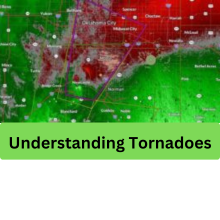
Oklahoma has been in the grips of severe weather, culminating in a tornado that recently hit the Oklahoma City metro. This storm, coupled with heavy rainfall, has led to significant flooding and ongoing weather alerts across the state. As we brace for another round of storms, it’s crucial to stay updated on the situation.
Importance of Staying Informed
In times of severe weather, information is power. Staying informed through reliable sources can mean the difference between safety and danger. It’s essential for residents to heed warnings and understand the risks associated with tornadoes and flooding.
The Impact of the Recent Tornado
Areas Affected
The tornado left its mark in several neighborhoods, particularly near Sooner Road and Interstate 240. Reports indicate widespread damage, with debris scattered across various locations, affecting homes and vehicles alike.
Damage Reports
Initial assessments reveal significant destruction. Homes suffered roof damage, and trees were uprooted, blocking roads and causing hazardous conditions for residents. Local news reports documented these scenes, providing real-time updates on the aftermath of the storm.
Current Weather Alerts
Tornado Warnings and Watches
As of early Sunday morning, multiple tornado warnings were issued for counties including Cleveland, McClain, and Oklahoma. These alerts indicate an immediate threat, prompting residents to seek shelter and stay vigilant.
Flash Flood Warnings
In addition to tornado warnings, flash flood alerts remain in effect for various counties. The combination of heavy rainfall and saturated ground increases the risk of flooding, posing a danger to those in low-lying areas.
Understanding Tornadoes
What Causes Tornadoes?
Tornadoes form from severe thunderstorms, specifically supercells, which create conditions conducive to funnel clouds. Warm, moist air meets cooler, dry air, leading to instability and the potential for rotation.
Common Myths About Tornadoes
Misconceptions abound regarding tornadoes. One common myth is that you should open windows to equalize pressure. In reality, this can worsen damage and increase risk during a tornado.
Safety Precautions
Preparing for Tornadoes
Preparation is key to survival. Residents should have an emergency plan that includes a safe room and supplies, such as water, non-perishable food, and a first aid kit. It’s also wise to have a battery-powered weather radio.
What to Do During a Tornado
When a tornado warning is issued, seek shelter immediately. The safest place is a basement or an interior room on the lowest floor of your home, away from windows. Cover yourself with a heavy blanket or mattress to protect against flying debris.
Post-Tornado Safety Tips
After the storm has passed, assess your surroundings carefully. Avoid downed power lines, and if you’ve sustained damage, report it to local authorities. Take photos for insurance claims and document any injuries.
The Role of Meteorologists
How Meteorologists Track Storms
Meteorologists use Doppler radar and satellite imagery to monitor weather patterns. This technology allows them to predict storm movements and issue timely alerts, keeping communities informed and safe.
Importance of Weather Alerts
Weather alerts are crucial for public safety. They inform residents of imminent threats, enabling them to take necessary precautions. Paying attention to local forecasts and alerts can save lives.
Also read: How to Stream Yellowstone Season 5 Part 2 on November 10
Community Response
Local Assistance and Resources
In the aftermath of a storm, local agencies often mobilize to provide assistance. This includes shelters for displaced residents and resources for those in need. Community support plays a vital role in recovery.
How to Help Affected Neighbors
Offering assistance to neighbors impacted by the storm is essential. Whether it’s helping with clean-up efforts or providing food and water, community solidarity can significantly aid recovery.
Future Weather Outlook
Predictions for Upcoming Storms
Meteorologists predict more severe weather could follow in the coming days. Residents should remain vigilant as the potential for additional storms looms, particularly in a climate where conditions can change rapidly.
Long-Term Weather Trends
Understanding long-term weather patterns helps communities prepare for future storms. Climate change and seasonal variations can impact storm frequency and intensity, making preparedness more crucial than ever.
Also read: The Diplomat Season 2 Ending Explained by Keri Russell & Cahn
Conclusion
Oklahoma’s recent weather events highlight the importance of preparation and community resilience. As we navigate through these turbulent times, staying informed and ready can help protect lives and property. Let’s remain vigilant, support one another, and prioritize safety as we face the challenges of severe weather.
FAQs
What should I include in my emergency kit?
Your emergency kit should contain water, non-perishable food, a flashlight, a first aid kit, necessary medications, and important documents.
How can I stay updated on weather alerts?
You can stay updated through local news stations, weather apps, and the National Weather Service’s website for real-time alerts and forecasts.
What are the signs of an approaching tornado?
Signs include a loud roar similar to a freight train, dark or greenish skies, and large hail. If you see a rotating, horizontal cloud, take shelter immediately.
Are there safe places to shelter during a tornado?
The safest places are basements or interior rooms on the lowest floors of buildings. Avoid windows and exterior walls.
How do I report damage after a storm?
Report damage to local authorities or your insurance company. Take photos of the damage for your records and claims process.
